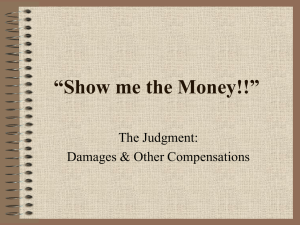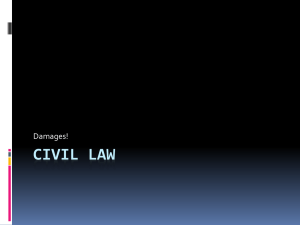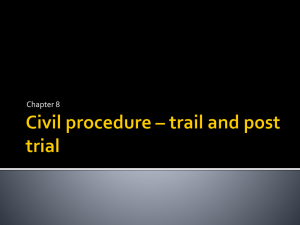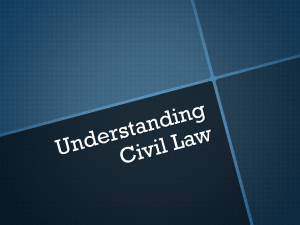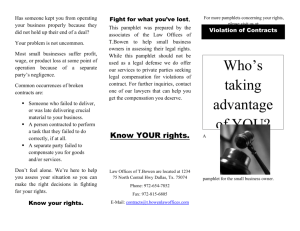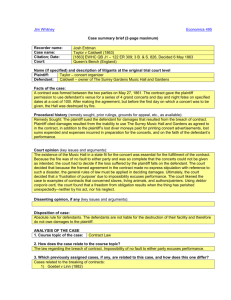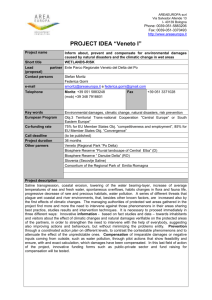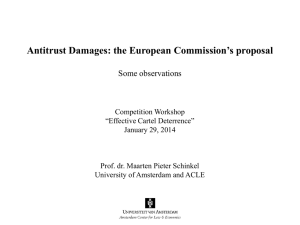Civil Law Intro
advertisement
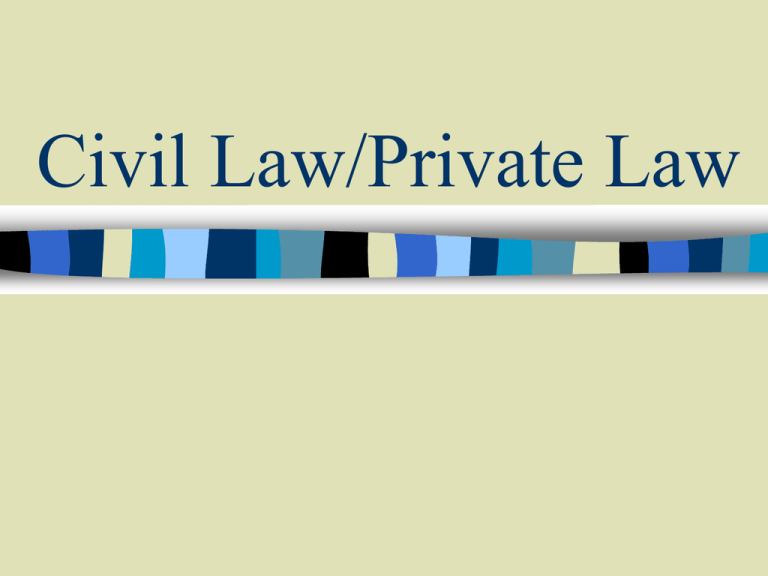
Civil Law/Private Law CIVIL LAW – law that governs the relationship between individuals Civil law deals largely with private rights and obligations. These include: Contractual rights Property rights Torts (civil wrongs) Parties are called litigants (Litigation is the action) Plaintiff- party that initiated the legal action Defendant-litigant against whom the action is taken ie: Pereira v. Ward Onus is on the plaintiff to prove the case on a “balance of probabilities”-the weighing of evidence to decide whether it is the plaintiff ’s or the defendant’s version of the events that is more convincing. What are some causes of Civil Action? Torts Breaches of Contract Consumer problems Unpaid Debts Landlord/tenant disputes Property disputes Family matters: adoption, custody, divorce etc. Bankruptcy Did you know that… Persons under the age of majority cannot sue or be sued in their own name. A minor who wishes to sue must be represented by an adult, known as a next friend. If an infant or a person “under a disability” is sued, the court will appoint a guardian or adult to act as the minor’s representative. This person is also known as a “guardian ad litem”. What are the courts involved? 1. Small Claims Court Referred to as “The People’s Court” Simple and inexpensive Concerns money and property $10 000 or less Examples: Landlord and tenant conflicts, consumer complaints, consumer debts, recovery of property from another Other Courts – Using the note define each: Provincial Supreme Court Court of Appeal Federal Court of Canada Supreme Court of Canada Civil Law Part 2 KINDS OF CLAIMS GENERAL DAMAGES SPECIAL DAMAGES PUNITIVE DAMAGES NOMINAL SPECIFIC PERFORMANCE INJUNCTIONS GENERAL DAMAGES I Pecuniary – monetary compensation for losses that can be calculated based on how much money the plaintiff lost. Example: car accident victim that confines the victim to a wheelchair for life. You can sue for damages to replace the car and also loss of future earnings. Q: How would age play a factor in complicating this matter? GENERAL DAMAGES II Non-pecuniary – terrible personal loss which does not involve an actual loss of money and is difficult to quantify. Example: pain and suffering, loss of a loved one, mental anguish, aggravated damages (humiliation or distress) CAN A PRICE BE PUT ON THESE? Judges will usually make the monetary compensation based on rule of precedent. However, there is a maximum of $280 000 (recently increased from $100 000 due to inflation) WHAT DO YOU THINK? SPECIAL DAMAGES -compensation for out of pocket expenses Example: medication, therapy, ambulance services, medical expenses, lost income (fixed period of time), car repairs PUNITIVE DAMAGES – punish the defendant for reprehensible /malicious conduct Example: false imprisonment or arrest, assault, battery, libel and slander NOMINAL -minimal compensation to acknowledge a moral victory Example: someone was using your land and you wanted them to stay off, you may be awarded $1 for you suffered no loss but merely wanted to assert your rights SPECIFIC PERFORMANCE -court order compelling someone to fulfill the terms of a contract Example: buy a puppy from a breeder but the breeder changes her mind and gives you your deposit back. You don’t want the deposit, you want the puppy! INJUNCTIONS a court order requiring someone to do or not do something Mandatory injunction – to do Prohibitory injunction – forbid to do *These may be permanent or temporary Example: apply dangerous chemicals, copyright trademarks, force striking workers to return to work ENFORCING A JUDGEMENT You are on your own. The court doesn’t cut a cheque. But….if the defendant doesn’t pay you can take the following steps: ENFORCING A JUDGEMENT Examination of a Judgment Debtor – being questioned under oath to find out about the debtor’s assets Garnishment – courts can order a % of wages, bank accounts be deducted to pay to plaintiff Execution or Seizure – sheriff seizes assets of debtor and sells them Alternative Sources of Compensation I Motor Vehicle Liability Insurance – money from the insurer of the defendant’s vehicle (only in motor vehicle accidents) Problem: not everyone has liability insurance II No Fault Insurance – provides immediate funds without evidence of fault III Worker’s Compensation – provincial Workers Compensation Fund IV Criminal Injuries Compensation – criminal injuries compensation boards have been created to compensate innocent victims when the assailant doesn’t have any assets or insurance. How does the Trial Work? In a trial by jury the judge instructs the jury on the law applicable to the facts of the case. The jury must consider this as well as other considerations: Who was at fault? Is that person totally at fault? (%) How should damages be determined? How much should they be? Class action suit – a lawsuit initiated by a group of people over a complaint common to all. Examples? Page 369-370 Google Class Action Benefits Avoid the necessity for many similar lawsuits Similar claims are treated similarly Eliminated barriers like economic barriers that prevent people from pursuing legal action
